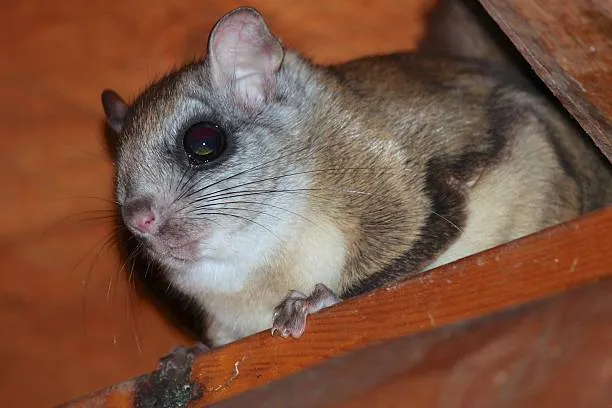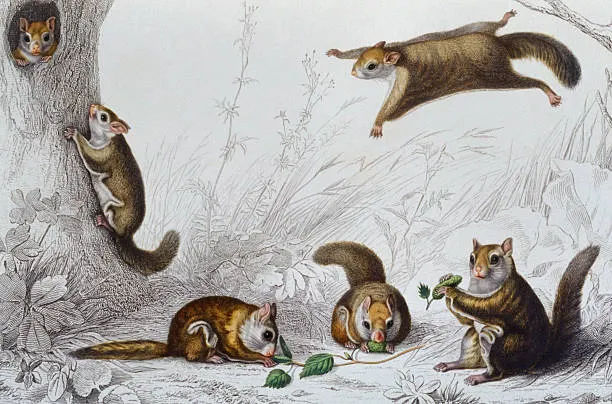“Flying Squirrels: Nature’s Silent Gliders of the Night Sky”

Flying squirrels belong to the tribe Pteromyini, a group within the squirrel family (Sciuridae). They are true squirrels that have evolved a unique ability to glide between trees using a patagium—a furry membrane stretching from wrist to ankle on both sides.
There are over 50 species of flying squirrels worldwide, classified into two main types:
- Old World flying squirrels – Found in Europe and Asia
- New World flying squirrels – Found in North and Central America
🌙 Nocturnal and Elusive
Flying squirrels are strictly nocturnal. Unlike their daytime squirrel cousins, they:
- Sleep in tree hollows or nests during the day
- Forage at night using excellent night vision
- Use their large eyes to navigate the darkness
- Are usually heard rather than seen due to their stealthy movements
Their gliding ability helps them move between trees without descending to the ground, avoiding predators like foxes, snakes, and owls.
✈️ How Do Flying Squirrels Glide?
Flying squirrels use the patagium to glide from tree to tree. When launching:
- They leap from a high branch.
- Stretch out their limbs to open the membrane.
- Use their tail as a rudder to steer and stabilize.
They can glide up to 45 meters (150 feet) or more in a single jump! The gliding helps them:
- Escape predators
- Save energy
- Locate food
- Connect tree canopies in dense forests
🏡 Habitat and Range
Flying squirrels are found in:
- North America – e.g., Northern and Southern flying squirrels
- Europe and Russia – Siberian flying squirrel
- Asia – Giant flying squirrels, found in India, China, and Southeast Asia
They prefer mature forests with large, old trees for nesting and gliding. Tree cavities, abandoned woodpecker holes, and leafy nests are common shelters.
🍄 What Do Flying Squirrels Eat?
They are omnivorous, with a highly adaptable diet:
- Fruits and berries
- Nuts and seeds
- Fungi and lichens
- Tree bark
- Insects
- Bird eggs (occasionally)
In winter, they often cache food in hidden spots for later use. Some species, like the Northern flying squirrel, play a crucial role in dispersing mycorrhizal fungi that help trees absorb nutrients.
👨👩👧👦 Social Behavior and Communication
Flying squirrels can be social animals, often sharing nests, especially in winter for warmth. Key behaviors include:
- Scent marking with glands on their cheeks
- High-pitched chirps and ultrasonic vocalizations for communication
- Mutual grooming in family groups
- Territorial gliding displays
They are not aggressive and are generally shy, gentle creatures.

🍼 Reproduction and Lifespan
- Mating season: Late winter to early spring
- Gestation period: Around 40 days
- Litter size: 2–6 young
- Baby squirrels are born hairless and blind
- Weaning: Around 6–8 weeks
Flying squirrels can live up to 5–6 years in the wild, and even longer in captivity.
🛡️ Predators and Threats
Flying squirrels face threats from both natural predators and human activities. These include:
- Owls, hawks, snakes, and raccoons
- Deforestation and habitat fragmentation
- Climate change
- Accidents from electrical wires or buildings
Some species, like the Siberian flying squirrel, are listed as Near Threatened or Vulnerable.
🌳 Role in the Ecosystem
Flying squirrels are important to forest health. They:
- Disperse fungal spores and seeds
- Serve as prey for many forest predators
- Help maintain forest diversity
Their presence indicates a healthy, mature forest, making them useful for ecological monitoring.
🏠 Can Flying Squirrels Be Pets?
While it’s legal to own flying squirrels in some places, they require:
- Special care due to their nocturnal habits
- A large, safe space for gliding
- A specialized diet and enrichment
- Veterinary care from an exotic animal specialist
They can bond with humans but are not suitable for casual pet owners.
🧠 Fun & Surprising Facts
- The Japanese dwarf flying squirrel looks like a real-life cartoon character.
- Flying squirrels can’t actually fly, but can steer mid-air better than some birds.
- Some species use glow-in-the-dark fur that appears pink under UV light—possibly for communication.
- Fossil records show flying squirrels have existed for at least 30 million years.

✅ Conclusion: Small Mammals with Big Superpowers
Flying squirrels are one of nature’s most unique small mammals, equipped with an elegant gliding system, a curious diet, and an important role in ecosystems. Though they are often hidden from view, their graceful presence reminds us of the rich biodiversity thriving in forest canopies.



